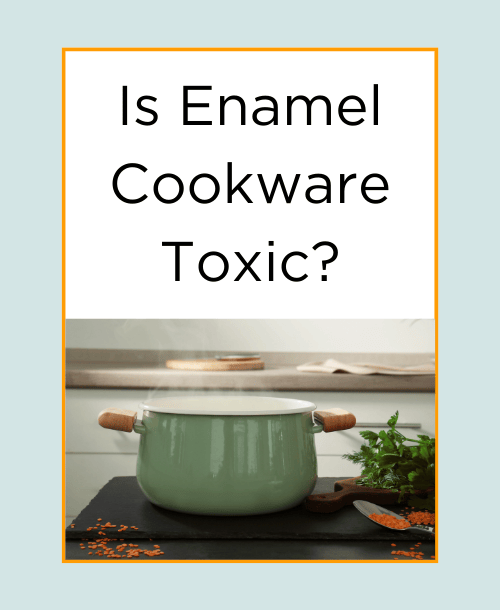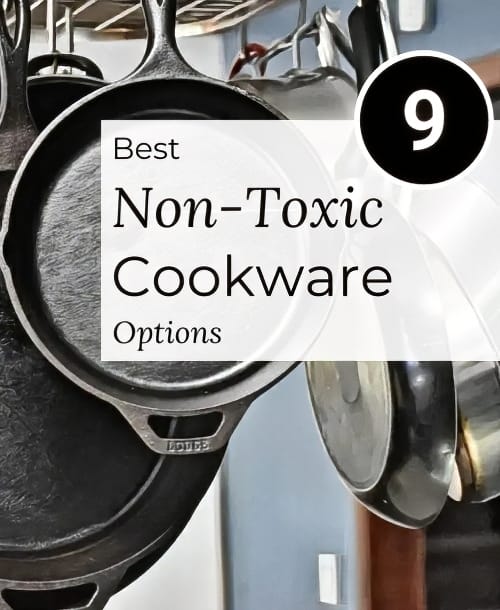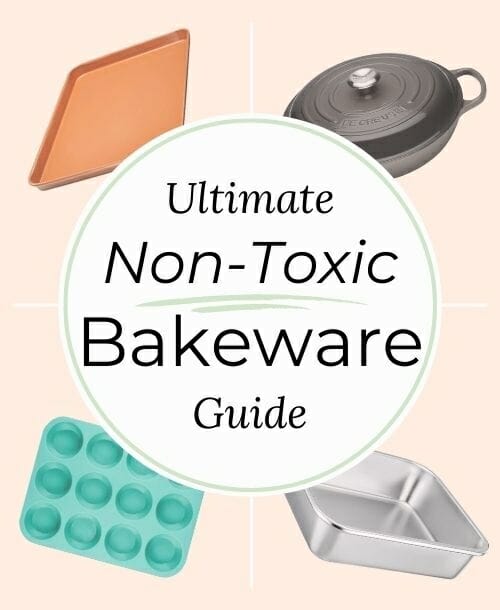
Enameled cast iron cookware combines the excellent heat distribution of cast iron with a non-toxic, non-reactive glass coating. But is it safe?
This guide demystifies the safety of enameled cast iron for your kitchen. We’ll explore its glass coating, how to care for it, and answer common questions like:
- Can I use high heat with enameled cast iron?
- What if it gets scratched?
- Is lead or cadmium a concern?
Don’t worry; modern enameled cast iron is safe. That said, there are a few things to remember to ensure safety.
Let’s get into it!
Medically-reviewed by Dr. Ahmad Alsayes, MBBS
What is Enameled Cast Iron Cookware?
Enameled cast iron is cast iron coated in a layer of enamel, essentially powdered glass fused to the surface at high temperatures.
This coating creates a durable, less sticky surface that doesn’t leach metals or interfere with the flavor of your food. It shines in places where bare cast iron doesn’t.
For example, I’m not reaching for my bare Lodge skillet to cook a tomato-based dish. It leaves a metallic taste in acidic foods. Enameled cast iron, on the other hand, doesn’t.
It’s also dish soap-friendly and doesn’t require seasoning upkeep, making it easier to clean. And enamel offers a greater aesthetic appeal, coming in various colors instead of standard matte black.
The Safety of Enameled Cast Iron Cookware
Enameled cast iron is safe for cooking, with a few considerations to ensure its durability and protect its non-reactive surface:

Avoiding Scratches:
While robust, enamel is not invincible. If you’re not careful, you can easily scratch it.
Use wooden or silicone utensils to prevent damaging the enamel. Also, do not apply excessive force with abrasives during cleaning, as this can damage the enamel layer. Instead, let the pan soak for 15 minutes to lift stubborn food debris.
And steer clear of older pans with worn-out enamel (thanks, but no thanks, antique store Dutch oven!).
Scratched or chipped enamel could expose the cast iron underneath, leading to rust or metallic leaching into acidic foods.
Temperature Management:
Enamel is quite heat-resistant, but it’s not immune to extreme temperatures.
Overheating can lead to discoloration or even chipping of the enamel coating. To prevent this:
- Avoid heating your enamel cookware above 500°F.
- Never leave an empty enamel pot or pan on a hot burner.
- Read your cookware’s label for maximum safe temperatures.
It’s also best to avoid sudden temperature changes (from hot to cold or vice versa), which can cause the enamel to crack.
Lead and Cadmium Concerns
Modern enameled cast iron cookware produced by reputable brands is generally free from harmful levels of lead and cadmium. While very trace amounts of lead and cadmium might be present on the exterior enamel of some cookware, they do not contact food.
Newer production techniques ensure these metals remain firmly bound within the enamel coating.
That said, some vintage enameled pots and pans (particularly those with vibrant colors like orange and red) used lead and cadmium additives.
To prevent lead leaching concerns, avoid antique or otherwise worn-out enameled pans. Prioritize brands known for transparency regarding third-party testing for lead and cadmium, like Le Creuset.
Read more: How to Tell if Dishes Have Lead (Actionable Guide)
Caring for Your Enamel: How to Maintain Safe Enamel Cookware
To maintain the safety and extend the life of your enameled cast iron cookware:
- Hand Washing: Ditch the dishwasher and abrasive scrubbers. Instead, opt for hand washing with mild soap and a non-abrasive sponge. Avoid using steel wool or harsh scouring pads.
- Utensil Selection: Banish metal utensils from your enameled pan’s vicinity. Opt for wooden or silicone utensils to prevent unsightly scratches. If you must use metal, do so gently.
- Mind the Flames: Cook on medium heat and avoid rapid temperature changes to protect the enamel.
- Thorough Drying: Ensure your cookware is entirely dry before storage to prevent moisture-related damage.
- Storage Savvy: Store with care to avoid chips or cracks. If stacking, use protectors between pots and pans.
Frequently Asked Questions
Is enameled cast iron dishwasher-safe?
Most manufacturers advise against putting enameled cast iron in the dishwasher, as harsh detergents and high heat can damage the enamel finish. We recommend hand washing with mild soap to preserve its appearance and durability.
Is Lodge enameled cast iron safe?
Yes, Lodge enameled cast iron is safe. It’s made without PFOA or PTFE and meets all FDA and California Proposition 65 standards for lead and cadmium content. This ensures its safety for cooking and food preparation.
Is enameled cast iron oven-safe?
Yes, enameled cast iron is oven-safe. Most enameled cast iron cookware can withstand temperatures up to 400-500°F. Still, it’s essential to check the manufacturer’s guidelines for specific temperature limits to ensure safety and prevent damage.
Is enameled cast iron broiler-safe?
Enameled cast iron is generally not recommended for use under a broiler. The intense direct heat from a broiler can damage the enamel coating. Always consult the manufacturer’s guidelines to avoid damaging your cookware.
How does enameled cast iron compare to traditional cast iron regarding safety?
Enameled cast iron is considered safer for cooking acidic foods, as the enamel coating prevents iron from leaching into the food, a concern with traditional cast iron. Both are safe for general cooking when used and cared for properly, but enameled offers an inert surface, reducing interaction with food.
Can damaged enameled cast iron cookware still be safe to use?
Minor chips or scratches in enameled cast iron cookware are generally safe for continued use if they’re on the exterior. However, damage to the cooking surface can expose the metal underneath, potentially leading to rust or metal leaching into food. In such cases, replacing the cookware is advisable.
Where can I find safe enameled cast iron cookware?
Find safe enameled cast iron cookware from reputable brands known for their quality and safety standards, such as Lodge, Le Creuset, and Staub. Look for products explicitly stating they meet FDA and California Proposition 65 standards for lead and cadmium content. Read more on the safest brands in our Non-Toxic Cookware Guide.
Final Thoughts
Enameled cast iron cookware combines the excellent heat retention of traditional cast iron with a modern, safe, and stylish glass coating. This type of cookware is safe for everyday cooking as long as you take a few precautions to keep it in tip-top shape.
Here’s a quick rundown:
- Be gentle: Avoid scratches and super high heat to protect the enamel coating.
- Modern is best: Newer enameled cast iron cookware is generally free of lead and cadmium.
- Clean with care: Handwashing and using gentle utensils will help your pot or pan last for years.
While ancient cookware or misused pieces can raise safety concerns, you can avoid these risks by choosing reputable brands and taking good care of your pan.
So, if you’re looking for safe and stylish cookware that delivers delicious results, enameled cast iron is a perfect choice for your kitchen!
P.S. Read our guide, 9 Best Non-Toxic Cookware Brand Picks, to see our pick for the best enamel cast iron pan, among many other types!

Hi there! I'm Adam, author and founder of TGL. Since 2016, I've produced and sold non-toxic kitchenware throughout the US. Today, I'm using my passion and experience in sustainable product manufacturing to help families avoid unsafe reusable foodware. When I'm not writing, you'll find me hiking or camping throughout Appalachia!



